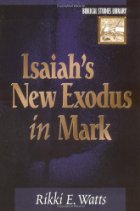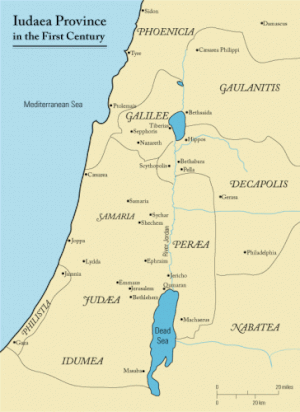Isaiah 52:13-53:12
The Suffering Servant
13 Behold, my servant shall prosper,
he shall be exalted and lifted up,
and shall be very high.
14 As many were astonished at him—
his appearance was so marred, beyond human semblance,
and his form beyond that of the sons of men—
15 so shall he startle many nations;
kings shall shut their mouths because of him;
for that which has not been told them they shall see,
and that which they have not heard they shall understand.
53 Who has believed what we have heard?
And to whom has the arm of the Lord been revealed?
2 For he grew up before him like a young plant,
and like a root out of dry ground;
he had no form or comeliness that we should look at him,
and no beauty that we should desire him.
3 He was despised and rejected by men;
a man of sorrows, and acquainted with grief;
and as one from whom men hide their faces
he was despised, and we esteemed him not.
4 Surely he has borne our griefs
and carried our sorrows;
yet we esteemed him stricken,
struck down by God, and afflicted.
5 But he was wounded for our transgressions,
he was bruised for our iniquities;
upon him was the chastisement that made us whole,
and with his stripes we are healed.
6 All we like sheep have gone astray;
we have turned every one to his own way;
and the Lord has laid on him
the iniquity of us all.
7 He was oppressed, and he was afflicted,
yet he opened not his mouth;
like a lamb that is led to the slaughter,
and like a sheep that before its shearers is dumb,
so he opened not his mouth.
8 By oppression and judgment he was taken away;
and as for his generation, who considered
that he was cut off out of the land of the living,
stricken for the transgression of my people?
9 And they made his grave with the wicked
and with a rich man in his death,
although he had done no violence,
and there was no deceit in his mouth.
10 Yet it was the will of the Lord to bruise him;
he has put him to grief;
when he makes himself an offering for sin,
he shall see his offspring, he shall prolong his days;
the will of the Lord shall prosper in his hand;
11 he shall see the fruit of the travail of his soul and be satisfied;
by his knowledge shall the righteous one, my servant,
make many to be accounted righteous;
and he shall bear their iniquities.
12 Therefore I will divide him a portion with the great,
and he shall divide the spoil with the strong;
because he poured out his soul to death,
and was numbered with the transgressors;
yet he bore the sin of many,
and made intercession for the transgressors.
Isaiah 53 and the Suffering Servant is a major text for Christianity (in the New Testament it is used to interpret Christ’s death) but what did it mean to adherents of Judaism before Christianity?
Did any Jewish interpretations anticipate the meaning it held for later Christians?
To what extent were the authors of the gospels innovative in their use of Isaiah 53 (and Isaiah as a whole)? To what extent were they simply employing ideas they absorbed from their surroundings?
Is it possible that Christianity itself evolved in part from earlier sectarian understandings of Isaiah 53?
Martin Hengel brings us a little closer to answering these questions when he offers insights into the influence this text had on various ideas in Second Temple Judaism:
Hengel, Martin, ‘The Effective History of lsaiah 53 in the Pre-Christian Period’, in The Suffering Servant: Isaiah 53 in Jewish and Christian Sources (ed. Bernd Janowski and Peter Stuhlmacher; Grand Rapids, MI: William B. Eerdmans, 2004), pp. 75-146.
Scholarship is used to thinking of the book of Isaiah as a collation of works originally by a number of authors (e.g. chapters 1-39 labelled Proto-Isaiah; 40-55 Deutero-Isaian; 56-66 Trito-Isaiah) but in the context Hengel is addressing the book was understood to be the unity we know today. Not only a unity but of prophetic significance as a whole. Hengel establishes early in his essay the point that from the Hellenistic period on the book of Isaiah (as a whole) was often treated in Judaism as work prophetic of the last days. So in Sirach (composed around 200 BCE — prior to the Maccabean era) we read of Isaiah the prophet:
24 He comforted the mourners in Jerusalem. His powerful spirit looked into the future, 25 and he predicted what was to happen before the end of time, hidden things that had not yet occurred. (Sirach 48:24-25 GNT)
Ben Sirach interprets Isaiah’s Servant — and prepares for the Gospel of Mark
The Gospel of Mark opens with a blend of prophetic passages from Isaiah and Malachi and allusions to the Exodus that lead directly into an Elijah scene. Two centuries earlier Ben Sirach similarly linked Isaiah, Malachi and Elijah in a pivotal prophetic time. Hengel does not draw the comparison with the Gospel of Mark (a comparison enriched by Elijah’s own association with Exodus and wilderness motifs) but I’m sure someone has:
Mark 1:2-4
Even as it is written in Isaiah the prophet,
Behold, I send my messenger before thy face, Who shall prepare thy way; The voice of one crying in the wilderness, Make ye ready the way of the Lord, Make his paths straight;
John came . . . clothed with camel’s hair, and had a leather girdle around his waist . . . [i.e., in role of Elijah]
Malachi 3:1
Isaiah 40:3
Exodus 23:20 |
Sirach 48:1, 7, 10
Then the prophet Elijah arose like a fire . . . who heard rebuke at Sinai and judgments of vengeance at Horeb . . .
You [=Elijah] who are ready at the appointed time, it is written,
to calm the wrath of God before it breaks out in fury, to turn the heart of the father to the son, and to restore the tribes of Jacob.
Malachi 4:5-6
Isaiah 49:6
|
Hengel cautiously expresses some doubt as to whether Sirach “wished to identify the Servant [of Isaiah] directly with Elijah redivivus.” He does, however, along with other scholars he cites recognize that Sirach has given Isaiah 49:6 “a messianic or at least an individual interpretation”. (The significance of an “individual” interpretation lies in the various interpretations of the Servant passages: some reading the Servant as an individual but others at the time viewing the Servant as a literary figure representing Israel. Compare how the “son of man” in Daniel 7 was originally composed as a representative of the nation of Israel — in contrast to gentile nations represented by wild beasts — yet came to be interpreted by some as a literal, heavenly individual.)
Was the author of the Gospel of Mark writing in the context of a long-known intellectual tradition that played with piecing Isaiah’s Servant, Malachi’s Messenger, Exodus liberation and adoption tropes, and Elijah into scenarios of messianic end times?
The Book of Zechariah interprets Isaiah 53?
Martin Hengel takes us further back than the Book of Sirach and to the period of the immediate successors of Alexander the Great, the Diadochi. Continue reading “The Influence of Isaiah’s Suffering Servant Before Christianity”
Like this:
Like Loading...



